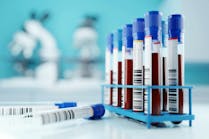All blood donations in the United States are “banked” after extensive testing. The analytes evaluated include markers of infectious diseases, the ABO/Rh blood group, and a check for blood group antibodies. In some instances, blood units are evaluated for the expression of additional minor blood group antigens. It is standard practice, as an additional safety check, for hospital transfusion services to re-test the blood group antigen status of blood units received into their inventory. Rare instances occur when results obtained by the transfusion service do not match those of the blood center. Since the units are labeled at the blood center, any testing discrepancies require a report to be filed to regulatory agencies.
For example, the blood center labels a unit as Group O Rh-positive. The hospital transfusion service repeats the ABO on all units and discovers that the unit weakly expresses Group A antigens; anti-A and anti-B are found in the serum. The lack of A antigens determined by the blood center made the forward and reverse ABO match. Testing by the receiving institution brought the discrepancy to light.
Further investigation reveals that the donor’s red cells express a subgroup of A, termed Ax, and there is anti-A1 in the plasma. This situation can occur, because the transfusion service uses a different anti-A reagent. Therefore, it is not surprising that agglutination may be observed with one reagent and not another for weakly expressed antigens.
The above scenario creates tension and a degree of uncertainty because the potentially mislabeled unit constitutes a “reportable event.” It is important to understand that, from time to time, there will be differences between the blood center and receiving lab results. It is the differences in reagents (along with methods and techniques) that reveal subtle differences in the variation of blood group antigen expression among humans. Rarely are discrepancies a “black and white” difference between two results.
Resolving blood group antigen discrepancies
What is the best way to resolve blood group antigen discrepancies?
- The transfusion service contacts the blood center and provides accurate documentation of its method and reagents used to discover the discrepancy.
- The blood center evaluates the discrepancy using serological and molecular immunohematology techniques.
- The investigation provides documentation of the serological problem and the identification of a blood group variant.
- The blood center quality services department assesses the impact.
A thorough serological and molecular investigation of the problem, and the follow-up, contributes to our knowledge of the blood group antigen variation in humans and the impact to transfusion recipients. These cases can lead to further refinement of reagents, methods, and techniques in the provision of blood for red cell transfusion.
Sample requirements
For serological investigations, red cells are easily obtained. However, red cells do not contain a nucleus and therefore contain no DNA. Whole blood is required to obtain white blood cells for DNA extraction and molecular analysis. The ideal source of blood for the investigation is the “retention tube” from the blood center. (Other anticoagulated samples are also suitable.) The age of the sample is not critical; the preference for whole blood is less than 14 days old. DNA and red cells can be retrieved from greater than two weeks of age, however.
An “integral segment” from a unit of leuko-reduced blood is not suitable for molecular analysis. Leuko-reduced blood contains only trace amounts of white blood cells. Although red cells and plasma from an integral segment can be useful as part of the serological workup, insufficient amounts of DNA can be extracted to perform routine molecular tests; the amounts of DNA that can be obtained make the analysis challenging. There are techniques available that can use unit segments, but the testing lab must validate these molecular enhancement techniques.
Molecular technology
Several molecular methods can be used to characterize the nucleotide variant of a gene. Typically, the polymerase chain reaction (PCR) is used to amplify a segment of genomic DNA containing one or more exons of a gene. The amplified DNA is then subjected to further analysis to reveal predicted sequence variation. The amplified DNA can be restriction enzyme-digested (RFLP: restriction fragment-length polymorphism), or the DNA can be specifically PCR-amplified using a set of amplimers that distinguish single nucleotide polymorphisms (SNPs). Other methods also evaluate single nucleotide variation. A more comprehensive approach is to subject PCR-amplified DNA fragments to complete nucleotide sequencing—Sanger sequencing being the most common today— in both directions. Nucleotide sequencing can reveal many variations, and further computational analysis can be used to explain the variation in antigen expression.
The path to discrepancy resolution
Serological re-testing with the blood center reagents and the reagents used by the transfusion service can reveal differences. Molecular testing can confirm the presence of nucleotide polymorphism(s), and determine whether they are the reason for the expression of a blood group antigen variant. A group of molecular tests are routinely used to provide the most comprehensive information for blood group variants which are known to be discrepant between reagents (Table 1). Two case studies will illustrate procedures for resolving blood group antigen discrepancies.
| Table 1. Examples of blood group antigen variation observed using serological reagents. |
Case study #1: subgroup of A mimicking Group O
Initial observations: A group O Rh-positive unit was sent to a local hospital as part of a standing order to replenish stock. A clinical laboratory professional performing the required ABO recheck with anti-A, -B observed weak (w+) hemagglutination. She informed her supervisor, and the unit was immediately quarantined. The ABO recheck was repeated with anti-A and anti-B revealing w+ hemagglutination with anti-A only. The unit was sent to the blood center for further evaluation.
Blood center evaluation: The packed red blood cell unit was from a male self-declared Caucasian who had donated blood 37 times. The retention tube from the blood donation was retrieved. DNA was extracted from 200 uL of blood, and serological evaluations were performed using the serum and red cells.
Serological studies: The red cells were nonreactive with the routine anti-A blood grouping reagent when tested on the PK7300 automated instrument and were weakly reactive (w+) when tested by a manual tube technique after incubation at RT for 10 minutes. The donor red cells were evaluated with three other FDA-licensed sources of anti-A. Two sources demonstrated weak (w+) hemagglutination, and the third reagent was non-reactive. The serum showed 3+ hemagglutination with group B red cells and was reactive (1+) with A1 and A2 red cells after incubation at RT for 60 minutes. Anti-A reactivity was 3+ when incubated at 4C for 60 minutes (group O red cells were nonreactive).
Molecular analysis: Genomic DNA was used to PCR-amplify ABO exons including their flanking regions. The amplified products were subjected to termination dideoxynucleotide sequencing. Sequence analysis revealed the following single SNPs: ABOc.261ΔG,646T>A,681G>A,771C>T,829G>A.
Conclusion: The SNPs were consistent with the presence of O01 and Ax03 alleles.1 The weak expression of A does not appear to significantly impact the red cell survival time in transfusion to group O recipients.
Case study #2. weak D type 2 in trans with r’ (Cde)
Initial observation: A blood donor, who historically phenotyped as group O Rh-negative, now phenotypes as group O Rh-positive. The unit was quarantined and 1 mL of EDTA anticoagulated whole blood was provided for serological and molecular investigations.
Blood center evaluation: The unit was from a female donor of unknown ethnicity who had made one previous donation. The laboratory noted that the anti-D reagents used for phenotyping had changed since the donor’s previous donation. DNA was extracted from 200 uL of blood, and the red cells were evaluated for D antigen expression using tube techniques.
Serological studies: The donor’s red cells were tested with four FDA-licensed antisera using the immediate spin and saline indirect antiglobulin test in accordance with the manufacturers’ specifications. All four anti-D reagents were negative using the immediate spin technique, and two of the four reagents were weakly reactive (w+) using a saline tube indirect antiglobulin test. The complete Rh phenotype of the donor was C+, E+, c+, e+.
Molecular analysis: Genomic DNA was evaluated for RHD SNPs using PCR and 5′ nuclease sensitive fluorogenic probes that target the nucleotide changes responsible for the most common weak D types 1, 2, 3, 4, 5, 11, and 17. A weak D type 2 was identified: RHDc.1154G>C.2
Conclusion: The donor’s Rh genotype is R2r’ (cDE/Cde). The weak D type 2 allele is in trans with an RHCE allele that expresses the C antigen. The D antigen copy number of weak D type 2 is approximately 450–800 antigens per red cell.3 The expression of C in tans to D further reduces D antigen expression due to the Ceppillini effect.4
The impact of blood group variation on transfusion recipients ranges from no discernible impact (Case 1) to a potential for an alloimmunizing event or accelerated destruction of red cells in a previously sensitized recipient (Case 2).5 Careful serological investigations can shed light on the variation seen in hemagglutination, with some of these observations well documented by the manufacturer. Other variants are not as easily characterized serologically and benefit from further molecular analyses to reveal the nucleotide changes. Computational analysis can help explain the cause of the variant antigen expression. After gathering analytics from cases and determining blood group antigen discrepancies, investigators can find ways and techniques to reduce amount of discrepancies of blood for red cell transfusion.
Gregory A. Denomme, PhD, FCSMLS(D), serves as Director of Immunohematology and Transfusion Services for the BloodCenter of Wisconsin.
References
- Olsson ML, Irshaid NM, Hosseini-Maaf B, et al. Genomic analysis of clinical samples with serologic ABO blood grouping discrepancies: identification of 15 novel A and B subgroup alleles. Blood. 2001;98(5):1585-1593.
- Wagner FF, Gassner C, Muller TH, Schonitzer D, Schunter F, Flegel WA. Molecular basis of weak D phenotypes. Blood. 1999;93(1):385-393.
- Wagner FF, Frohmajer A, Ladewig B et al. Weak D alleles express distinct phenotypes. Blood. 2000;95(8):2699-2708.
- Ceppellini R, Dunn LC, Turri M. An interaction between alleles at the RH locus in man which weakens the reactivity of the Rh(0) factor (D). Proc Natl Acad Sci USA. 1955;41(5):283-288.
- Flegel WA, Khull SR, Wagner FF. Primary anti-D immunization by weak D type 2 RBCs. Transfusion. 2000;40(4):428-434.





